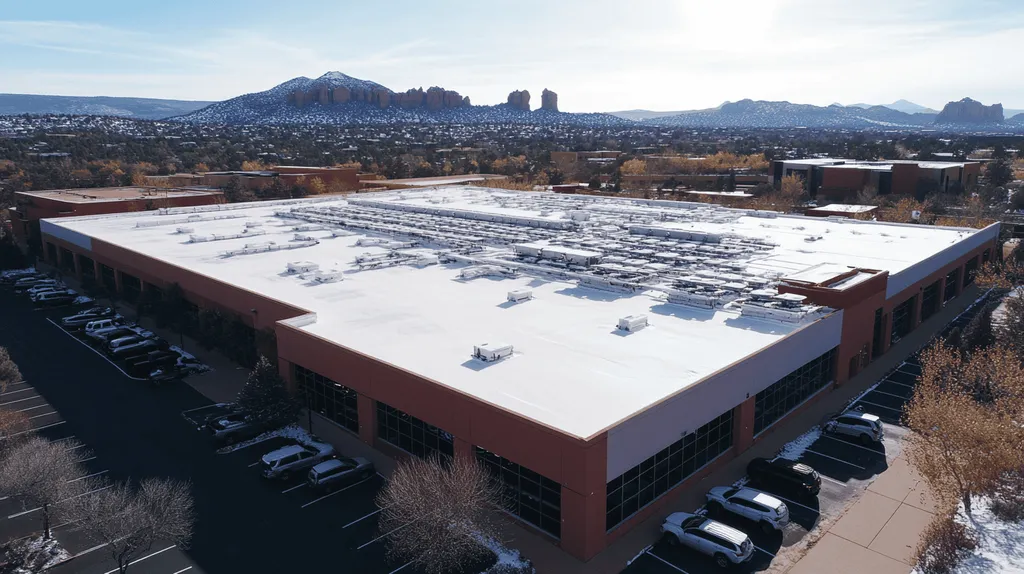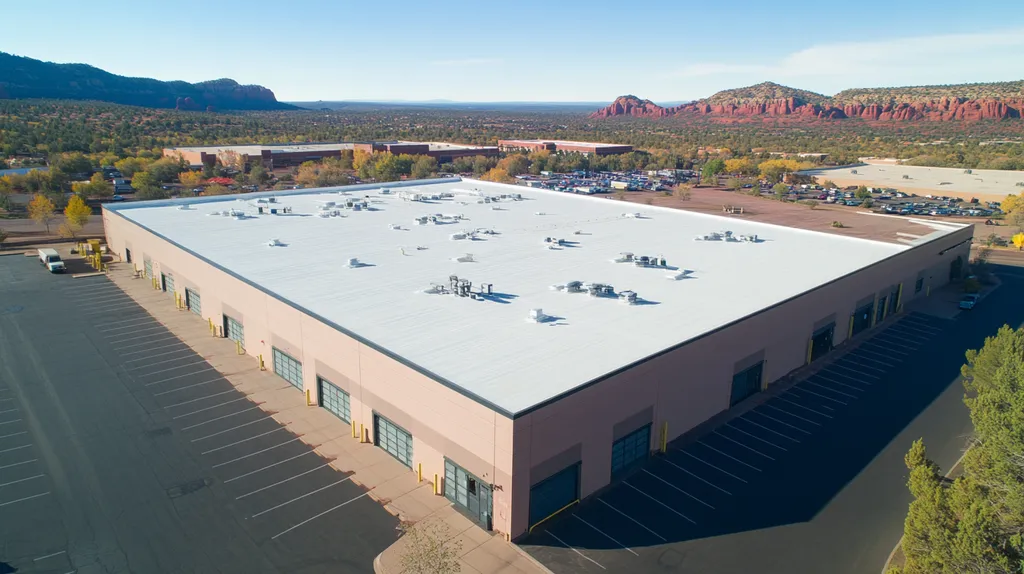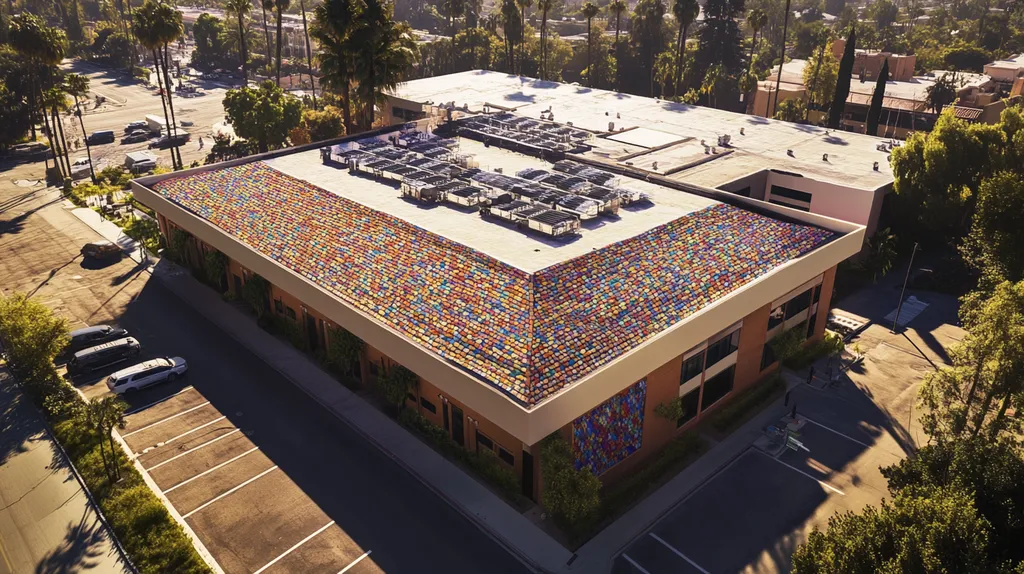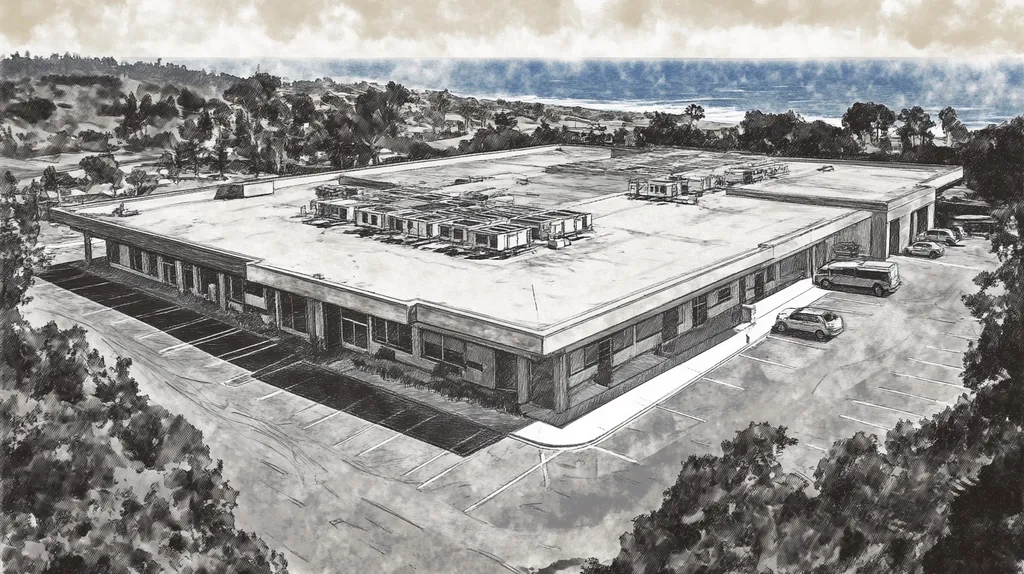The commercial roofing industry generates over 10 million tons of waste annually, with traditional application methods contributing significantly to this environmental burden. Studies indicate that up to 25% of roofing materials become waste during installation, leading to unnecessary costs and environmental damage.
These concerning statistics highlight systemic issues in current roofing practices, from inadequate pre-planning to inefficient material handling.
By examining established techniques and exploring innovative alternatives, property owners and facility managers can dramatically reduce waste while improving their bottom line.
SECTION 1: CURRENT PRACTICES
The commercial roofing sector produces an alarming amount of waste, with nearly 10 million tons of roofing materials ending up in landfills annually in the United States. This statistic underscores the urgent need for a comprehensive reevaluation of application and waste management methods. Outdated disposal techniques, inadequate waste management procedures, and the challenges of regulatory compliance are critical issues that exacerbate this waste crisis. Gaining insight into these problems is the first step toward implementing more efficient and sustainable roofing solutions.
Standard Disposal Methods
Many commercial roofing projects depend on conventional disposal methods, primarily sending waste to landfills. As a result, significant volumes of materials—such as old roofing membranes, insulation, and flashing—are discarded. This landfill reliance often leads to the loss of recyclable items, further harming the environment.
In practice, many roofing contractors do not have effective systems to segregate recyclable materials from regular waste. Consequently, valuable insulation and rubber roofing materials frequently end up in landfills instead of being repurposed. Transitioning to more efficient disposal methods can greatly reduce waste and lower overall disposal costs.
Moreover, the costs associated with dumping roofing materials can be substantial, especially in urban settings where landfill space is at a premium. This financial strain can significantly impact project budgets and a company’s profits. Finding alternative disposal solutions is vital for enhancing both sustainability and profitability.
As the roofing industry evolves, it is crucial to embrace recycling and repurposing roofing materials. Utilizing advanced disposal technologies can substantially diminish landfill contributions and encourage eco-friendly practices within the roofing community.
Common Waste Management Protocols
The lack of standardized waste management protocols in the roofing industry results in inconsistent practices across projects. Many contractors rely on subjective criteria to determine salvageable materials, leading to excessive waste. This inconsistency complicates waste tracking and decreases the likelihood of process improvement.
Furthermore, numerous roofing companies neglect to establish comprehensive waste management plans, which could significantly minimize waste generation. These plans should detail clear strategies for sorting, recycling, and disposing of materials. Without adequate planning, valuable items like metal scraps and old membranes are often disposed of unnecessarily.
The ambiguity in current guidelines makes it challenging for facility managers and property owners to navigate their waste management options. By implementing structured waste management protocols, communication among all stakeholders can improve, optimizing resource use.
A widespread adoption of standardized waste management practices is critical. Emphasizing accountability and best practices can lead to reduced waste and foster responsible environmental stewardship in the roofing sector.
Regulatory Compliance Challenges
Addressing regulatory compliance poses a significant hurdle for commercial roofing projects. Many jurisdictions enforce strict waste disposal regulations, complicating the safe handling of roofing materials. Non-compliance can result in costly fines and damage a roofing company’s reputation.
Adding to the challenge, the regulatory landscape is constantly changing, making it essential for contractors to stay updated on new requirements. Non-compliance not only wastes time and resources but can also increase overall waste generation, emphasizing the need for proactive education and training.
Contractors must remain informed about local regulations concerning hazardous materials and waste disposal. Insufficient training in these areas can lead to accidental violations and improper materials handling, thereby increasing waste levels.
Raising compliance awareness through targeted training can alleviate regulatory risks. Developing resources to assist contractors in understanding and adhering to regulations will help minimize waste while establishing a framework for responsible roofing applications.
SECTION 2: SYSTEMIC ISSUES
Commercial roofing practices are a significant contributor to waste, leading to serious environmental repercussions. Each year, construction and demolition activities in the United States generate around 600 million tons of waste, much of which ends up in landfills. This systemic issue not only leads to resource depletion but also accelerates climate change. Understanding the inefficiencies inherent in current roofing practices is essential for property owners and facility managers seeking to implement more sustainable solutions.
Environmental Impact of Landfills
The effect of landfill waste from roofing activities is profound. Landfills generate methane, a potent greenhouse gas that significantly contributes to global warming. Materials like asphalt shingles, commonly found in roofing, can take decades to decompose, worsening this situation.
Property owners must acknowledge that irresponsible disposal methods result in long-term ecological harm. By neglecting the waste generated during roofing projects, businesses may unintentionally support detrimental practices that disrupt local ecosystems.
Exploring alternative waste management strategies could greatly reduce the ecological impact of roofing projects. Establishing recycling initiatives for roofing materials can lessen landfill contributions and foster a circular economy.
Additionally, opting for sustainable materials decreases the amount of waste produced at every job site. This shift is not only advantageous for the environment; it also showcases a commitment to corporate social responsibility.
Inefficiencies in Material Segregation
Another critical issue in commercial roofing is the lack of efficient material segregation during installation. Many projects currently do not have organized systems to separate reusable materials from waste, resulting in valuable resources ending up in landfills.
Without proper segregation, high-quality materials earmarked for recycling frequently become waste. Research suggests that up to 30% of roofing materials could be salvaged if correctly sorted on-site.
Employing clear segregation practices can streamline waste management efforts. This strategy not only reduces overall waste but can also decrease disposal costs for property owners. Facilities managers should emphasize training for their teams on effective sorting techniques to maximize recovery.
Moreover, embracing innovations in waste management, such as mobile applications for tracking and managing materials, can improve efficiency and accountability throughout the roofing process.
Safety Risks in Waste Handling
Waste handling risks present a pressing challenge for the roofing industry. Ineffective waste management does not merely exacerbate environmental issues; it also jeopardizes worker safety. Improper disposal or storage of roofing materials can result in accidents and hazardous conditions on job sites.
For instance, accumulated debris can lead to slip and fall incidents, compromising workplace safety for crew members. In fact, injuries related to inadequate waste management contribute significantly to job-related accidents each year.
To address these risks, property owners must enforce stringent safety protocols for waste handling. Regular training sessions and clear guidelines are essential to minimize accidents and protect employees, thereby fostering a safer working environment.
Prioritizing safety not only shields the workforce but also enhances overall project efficiency. A safer job site translates to fewer delays and boosts the likelihood of successful roofing outcomes.
SECTION 3: MISSED OPPORTUNITIES
In the pursuit of effective roofing solutions, many commercial property owners miss crucial opportunities to cut down on waste. Construction and demolition debris accounts for approximately 25-30% of the total solid waste in the United States, according to the U.S. Environmental Protection Agency. By emphasizing recycling and reusing materials, the roofing industry can significantly diminish its environmental impact. This section delves into the overlooked potential of recycling, the advantages of reusing construction materials, and the economic benefits that come with sustainable practices.
Untapped Potential of Recycling
The recycling potential within the roofing industry is substantial yet remains largely unutilized. Many materials such as asphalt shingles can be effectively recycled into new products, but currently only a small fraction is diverted away from landfills.
By instituting dedicated recycling programs, roofing contractors can significantly minimize waste during installation processes. For instance, some companies are already gathering used materials to send to recycling facilities, which not only reduces waste but also champions sustainability.
Additionally, these recycling efforts can bolster a company’s reputation. As clients increasingly seek out environmentally responsible contractors, organizations that commit to recycling can distinguish themselves in a competitive marketplace.
A strong recycling framework not only curtails environmental impacts but also enhances operational efficiency. This sustainable value proposition is one that property owners should prioritize in their roofing projects.
Benefits of Reusing Construction Materials
Reusing existing materials during roofing projects presents numerous advantages beyond merely reducing waste. Salvaging components like metal flashing or tiles aids in conserving natural resources and cutting down on the carbon emissions associated with producing new materials.
Often, facility managers overlook the significant cost savings that can be achieved through the reuse of materials. Incorporating salvaged elements can lead to substantial reductions in both procurement and disposal costs, along with shortened project timelines from reduced material sourcing needs.
Moreover, repurposing materials encourages creativity among contractors to develop innovative solutions that improve building performance while minimizing waste. By fostering a culture of sustainability, this practice aligns with modern construction standards and the growing demand for eco-conscious approaches.
Ultimately, adopting the reuse of construction materials can transform project methodologies, presenting an innovative strategy that optimizes both environmental and financial outcomes.
Economic Gains from Sustainable Practices
The economic benefits of sustainable roofing strategies are significant and deserve attention. Investing in waste reduction and sustainable techniques can lead to long-term financial savings that balance out initial expenditures. Property owners focused on sustainability often experience reduced maintenance costs and enhanced property value over time.
Industry studies indicate that buildings employing sustainable materials and methodologies can achieve energy savings of up to 30%. Such reductions in energy use translate into considerable cost savings for both owners and facility managers, further encouraging the adoption of sustainable practices.
Additionally, companies that prioritize waste reduction may qualify for various tax incentives and rebates. These monetary advantages further solidify the financial argument for embracing sustainable roofing methods.
In conclusion, recognizing and leveraging the economic potential of sustainable roofing practices is essential. By incorporating these methods, property owners can secure both immediate and lasting benefits while contributing to broader environmental goals.
SECTION 4: ROOT CAUSES
The rising costs associated with roof waste present significant challenges for property owners and facility managers. Statistics reveal that up to 25% of roofing materials can become waste during installation, impacting both the bottom line and the environment. To effectively combat this growing issue, it is essential to identify the root causes of excessive waste generation. Three key factors include lack of pre-project planning, inadequate training and resources, and insufficient regulatory enforcement.
Lack of Pre-Project Planning
One major factor contributing to roofing waste is the absence of thorough pre-project planning. When a project lacks a well-defined plan, miscalculations and material shortages can quickly arise. For example, without precise measurements and comprehensive designs, contractors may over-order materials, generating excess that frequently ends up in landfills.
Additionally, poor initial assessments can lead to unsuitable material selection, complicating disposal and recycling efforts. Effective planning requires the involvement of all stakeholders from the beginning, fostering a clearer understanding of project requirements and driving down unnecessary material purchases. By implementing stricter planning protocols, waste levels can be significantly reduced.
Involving experienced project managers is also vital, as they can ensure that all critical factors, such as structural integrity and weather conditions, are taken into account. This collaborative approach results in more efficient installations and less waste. Furthermore, investing in software tools that assist with project planning can enhance accuracy and assist contractors in visualizing their needs, ultimately benefiting waste management outcomes.
Inadequate Training and Resources
The skills of roofing personnel are pivotal in minimizing waste. Many installers lack appropriate training on material handling and installation methods, leading to incorrect usage and increased on-site waste. For instance, improper cutting techniques can generate unusable scraps that could have been utilized more effectively.
Training programs that incorporate practical experience in waste management can help alleviate this issue. By equipping workers with essential skills, the potential for waste can be significantly diminished. Moreover, access to the right resources is critical; without appropriate tools and equipment, workers may rely on inefficient methods that produce excess waste.
Manufacturers can play a crucial role by providing training materials and resources that bridge the existing knowledge gap in the industry. Encouraging ongoing education for contractors ensures that the latest practices and technologies are effectively implemented, leading to more sustainable roofing projects.
Insufficient Regulatory Enforcement
The importance of regulatory frameworks in managing roofing waste is profound. Unfortunately, many regions face challenges with inconsistent enforcement of existing regulations, leaving contractors with little motivation to adopt waste reduction practices. For example, when disposal and recycling regulations are not consistently enforced, a culture of neglect can develop regarding waste management.
Strengthening regulatory compliance can incentivize contractors to implement waste-reducing measures. Regular inspections and adherence to guidelines can establish accountability that encourages sustainable practices. Moreover, promoting stricter on-site regulations can further bolster these efforts; requiring documentation of waste management strategies as part of project proposals compels companies to prioritize minimizing waste.
Ultimately, robust regulatory enforcement, combined with effective penalties for non-compliance, can drive improvements in construction methods. A strong emphasis on sustainable practices within regulatory frameworks is essential for achieving significant reductions in roofing waste.
DATA DRIVEN EVIDENCE
The need for sustainable roofing practices is increasingly urgent. The commercial roofing industry generates around 11 million tons of waste annually in the United States, presenting a significant environmental challenge. This substantial waste often stems from outdated application techniques that lead to excess materials. By analyzing waste generation data and exploring innovative practices, the industry can significantly mitigate its environmental impact and reduce operational costs. This section will focus on statistical analysis, insightful case studies, and the economic implications of better waste management in commercial roofing.
Statistical Analysis of Waste Generation
Annually, approximately 2.5 billion square feet of roofing material is installed across the United States, with nearly 30% ultimately discarded as waste. This waste primarily results from inefficient cutting and installation processes. The data also reveals that failures in roofing contribute significantly to waste generation, signaling a critical need for improved planning and material forecasting.
A recent report by the National Roofing Contractors Association highlights that over 40% of roofing waste is due to excess inventory and necessary rework. By implementing structured planning and installation techniques, these waste percentages could be lowered dramatically.
Utilizing data analytics and forecasting tools allows roofing companies to predict their material needs with greater accuracy. This proactive stance minimizes excess and substantially decreases landfill contributions.
Moreover, incorporating statistical insights can empower property owners to make informed decisions, further enhancing sustainability and reducing costs throughout the roofing lifecycle.
Case Studies on Sustainable Practices
A number of innovative companies have positioned themselves as leaders by adopting sustainable roofing practices. A prominent manufacturing facility in Ohio, for instance, successfully integrated pre-cut roofing systems into its projects, achieving a remarkable 50% reduction in material waste during installation.
Another noteworthy example comes from a distribution center in California, which implemented a comprehensive recycling program for scrap materials. This initiative not only diverted waste from landfills but also realized significant savings on disposal processes, effectively showcasing the economic advantages of a circular approach.
Additionally, pilot projects utilizing drones for roof inspections have been introduced, identifying issues before they escalate and minimizing waste tied to unforeseen repairs.
By highlighting these successful case studies, the roofing industry can inspire others to adopt innovative strategies that significantly reduce waste and promote a more sustainable future.
Economic and Environmental Impact Data
The financial benefits of reducing roofing waste cannot be overstated. Estimates suggest that cutting waste by just 10% in roofing projects could save the industry over $850 million annually, primarily through reduced material purchases and lower landfill fees.
Environmentally, the construction sector is responsible for more than 30% of global waste generation. By implementing waste-reduction techniques, the commercial roofing industry can make a substantial impact on its carbon footprint.
Sustainable roofing practices also enhance energy efficiency, leading to lower utility bills. Research indicates that energy-efficient roofs can reduce energy costs for building owners by 10-20% monthly.
Ultimately, the undeniable economic and environmental advantages of waste reduction underscore the necessity for innovative roofing strategies. Transitioning to these best practices is not merely an option—it is a crucial step towards a sustainable future.
SECTION 6: ALTERNATIVE SOLUTIONS
The pressing need to minimize waste during commercial roof application cannot be overstated. In 2018, construction and demolition projects produced a staggering 600 million tons of debris, a significant portion of which stems from roofing activities. By adopting alternative solutions, the industry can substantially reduce these figures, benefiting environmental goals as well as financial outcomes. This section explores three effective strategies: implementing recycling and upcycling, partnering with professional waste services, and adopting alternative disposal methods.
Implementing Recycling and Upcycling
Integrating recycling and upcycling into roofing projects can significantly minimize waste and even reduce costs. Various roofing materials like asphalt shingles and metals are recyclable; for example, used shingles can be transformed into asphalt for roadways, closing the recycling loop.
Upcycling takes this concept further by giving old materials a new lease on life in innovative ways. Metal flashings from old roofs can be reimagined as decorative panels or planters, diverting waste from landfills while enhancing property aesthetics.
Creating a successful recycling and upcycling program necessitates collaboration between property owners, suppliers, and contractors. It’s important to choose roofing professionals who place a high priority on sustainability and maintain relationships with recycling facilities.
Furthermore, educating the workforce on the value of recycling and upcycling is essential. A well-informed team is more likely to apply these practices consistently, leading to continuous waste reduction.
Partnering with Professional Waste Services
Collaborating with specialized waste management services can significantly enhance waste reduction efforts. Such services focus on the efficient collection, recycling, and disposal of construction debris, ensuring that the maximum amount of material is diverted from landfills.
By working with these experts, property owners can improve waste sorting throughout roofing projects. Professional waste management companies often have reliable recycling streams, simplifying responsible disposal methods.
Additionally, these partnerships can offer cost savings. Waste service providers can identify opportunities for recycling and proper disposal that may reduce landfill fees, making the overall financial impact more favorable.
To optimize these partnerships, property owners should begin by researching local waste services that understand the unique requirements of roofing projects. Regular communication can ensure that waste management goals are aligned and effectively executed.
Adopting Alternative Disposal Methods
Exploring alternative disposal methods is crucial for minimizing the environmental impact of roofing work. Traditional disposal routes often lead to excessive landfill contributions, while alternative options present more sustainable avenues.
For instance, composting organic materials from roof gardens can enrich soil rather than contribute to landfill weight. This approach not only cuts disposal costs but also supports local ecosystems.
Additionally, embracing a circular economy methodology allows materials from one roofing project to serve as resources for another. Property owners can connect with other businesses seeking specific roofing materials that might otherwise go to waste.
Moreover, partnering with local community organizations for material donations can further reduce landfill contributions. This not only aids in waste diversion but also fosters a sense of community goodwill.
The Bottom Line
The commercial roofing industry’s current trajectory of generating over 10 million tons of annual waste is environmentally and economically unsustainable.
With up to 25% of roofing materials becoming waste during installation, the industry must transition from traditional application methods to more sustainable practices.
By implementing comprehensive pre-planning, enhancing worker training, and adopting innovative recycling programs, property owners can reduce waste by up to 50% while realizing significant cost savings.
The data clearly demonstrates that sustainable roofing practices not only protect the environment but also offer substantial returns on investment through reduced material costs and lower disposal fees.
The time for transforming commercial roofing practices is now – the environmental and financial costs of inaction are simply too high to ignore.
FREQUENTLY ASKED QUESTIONS
Q. What current practices lead to waste in commercial roofs?
A. The commercial roofing sector generates substantial waste due to outdated disposal methods and inadequate waste management protocols. Many roofing projects rely heavily on landfills, causing recyclable materials to be discarded. Improving disposal techniques can significantly reduce waste and enhance sustainability.
Q. How do systemic issues affect waste in industrial roofing?
A. Systemic issues, such as ineffective material segregation and safety risks, contribute significantly to waste in industrial roofing. The lack of organized systems leads to valuable resources being discarded. Addressing these inefficiencies is essential for improving waste management in roofing projects.
Q. What missed opportunities exist in managing commercial roof waste?
A. Many commercial roofing projects overlook opportunities for recycling and reusing materials. By implementing dedicated recycling programs, property owners can significantly reduce waste and enhance sustainability. Recognizing these opportunities can lead to substantial cost savings and improved environmental outcomes.
Q. What are the root causes of waste in commercial roofs?
A. Key root causes of waste in commercial roofing include inadequate pre-project planning, insufficient training, and poor regulatory enforcement. Without a well-defined plan, miscalculations can lead to excess materials that end up in landfills, exacerbating waste generation.
Q. What data supports the need for better waste management in roofs?
A. The commercial roofing industry generates approximately 11 million tons of waste annually, highlighting the urgent need for improved practices. Studies show that better planning could reduce waste by nearly 30%, emphasizing the potential financial and environmental benefits of sustainable roofing methods.
Q. How can alternative solutions reduce waste in industrial roofing?
A. Implementing alternative solutions, such as recycling and partnering with waste services, can greatly reduce waste in industrial roofing. By adopting these strategies, property owners can minimize landfill contributions and improve overall project efficiency, benefiting both the environment and budget.
Q. What options exist for sustainable roofing materials?
A. Sustainable roofing materials include options such as recycled metal, TPO, and reflective coatings. These materials can enhance energy efficiency and durability, helping to reduce overall waste while contributing to environmental sustainability. Integrating sustainable materials is a proactive measure for long-term financial and ecological benefits.











